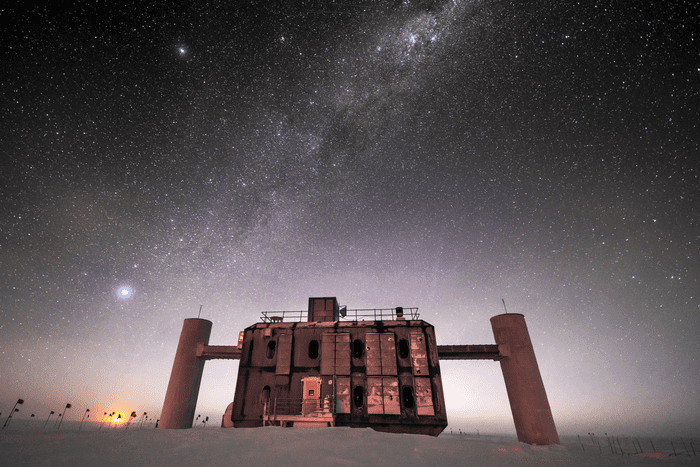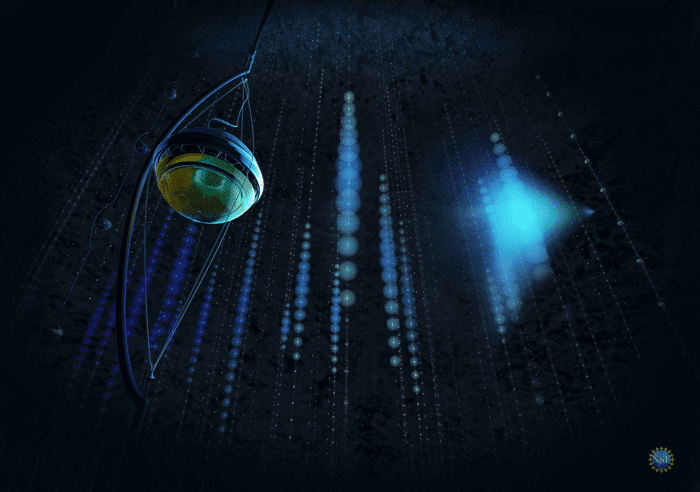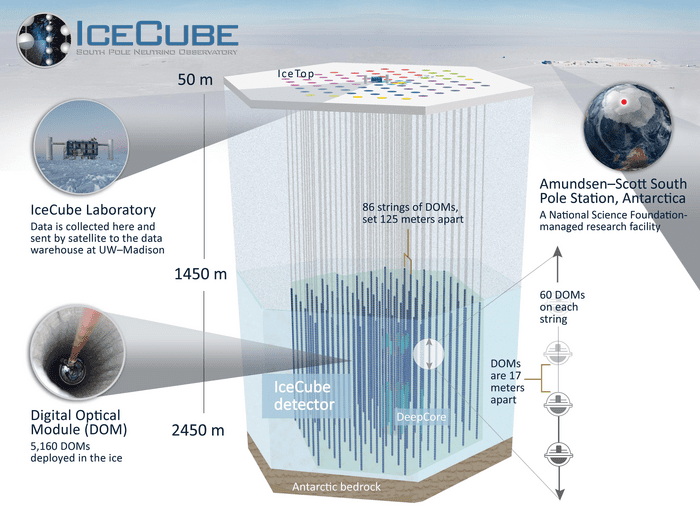Messier 77, also known as NGC 1068, is one of the most studied galaxies outside our own, but it can still surprise. Beloved by amateur astronomers for its beautiful spiral shape, Messier 77 has been revealed to be producing many high-energy neutrinos. To find this out researchers had to go, not into space or to the tops of mountains as with most astronomy, but kilometers deep beneath the Antarctic ice. The discovery could help explain the abundant cosmic neutrinos coming from all directions.
Neutrinos were first proposed in 1930, because physicists noticed the products of some nuclear reactions had less energy and momentum than existed beforehand. Since this violates all sorts of laws, it was concluded that there must be a missing particle they weren’t detecting, but it took 26 years to find the particle that fitted the necessary requirements.
We now know the universe is filled with cosmic neutrinos, with billions passing through us every second. They’re so hard to detect, however, that we find very few, and remain uncertain as to their sources. However, a new paper reveals Messier 77 is producing quite a lot of them, and it’s probably representative of a class of galaxies that do the same. This could explain why more high-energy neutrinos exist than could be attributed to previous known sources.
The discovery of a burst of neutrinos associated with SN 1987A, the closest supernova to Earth in centuries, demonstrated that exploding stars provide a major source for cosmic neutrinos. However, if there was a supernova in Messier 77 we’d expect to know about it. At 47 million light-years away it’s a lot more distant than 1987A, but still closer than the vast majority of supernovas we detect each year.
The IceCube Observatory made the first discovery of a high-energy neutrino source, TXS 0506+056, in 2018, almost 100 times as distant as Messier 77, and appropriately located off the shoulder of Orion. However, there doesn’t seem to be much similarity between the two. TXS 0506+056 is a blazar, a type of galaxy whose supermassive black hole’s near-lightspeed jets are pointed towards Earth. TXS 0506+056 allowed scientists to conduct simultaneous observations of the gamma rays and neutrinos produced by these jets.

The IceCube observatory at twilight looks like an alien construction, but it is actually a unique tool for exploring the universe. Image credit: Martin Wolf, IceCube/NSF
Although Messier 77 has an unusually active supermassive black hole for the local universe, no jets have been detected, making it what is known as a radio-quiet Active Galactic Nucleus (AGN).
“Radio-quiet AGNs…which are more abundant than blazars and radio-loud AGNs might help explain the amount of cosmic neutrinos observed,” said Dr Kohta Murase of Pennsylvania State University in an accompanying Perspective.
“After the excitement in 2018 of the discovery of neutrinos from TXS 0506+056, it’s even more thrilling to find a source producing a steady stream of neutrinos that we can see with IceCube,” said co-author Dr Gary Hill of the University of Adelaide in a statement.

Artist’s impression of the lights given off by muons within the ice when produced by neutrinos hitting atomic nuclei. Image credit: Nicolle R. Fuller, IceCube/NSF
“One neutrino can single out a source. But only an observation with multiple neutrinos will reveal the obscured core of the most energetic cosmic objects,” said Professor Francis Halzen of the University of Wisconsin-Madison in a separate statement. “IceCube has accumulated some 80 neutrinos of teraelectronvolt energy from NGC 1068, which are not yet enough to answer all our questions, but they definitely are the next big step towards the realization of neutrino astronomy.”
Neutrinos interact so poorly with ordinary matter their source is not hidden by dust clouds. Unfortunately, it’s hard to work out what is producing the neutrinos if we can’t see their source directly.
Neutrinos’ weak interactions force their detectors have to operate by looking for the flashes of light emitted on the rare occasions neutrinos create muons when hitting atomic nuclei.

The IceCube Laboratory relies on 86 strings that detect flashes of light within the cubic kilometer of ice it studies. Image credit: University of Adelaide
By building bigger and deeper detectors it is possible to capture more neutrinos, and those moving faster and therefore carrying more energy. IceCube gen-2 is planned. Not only will this allow scientists to learn more about Messier 77, it will be possible to compare the nearby galaxy with similar but more distant neutrino producers.
“It’s as if IceCube handed us a map to a treasure trove,” Dr Marek Kowalski of Deutsches Elektronen-Synchrotron said.
The paper is published in Science, along with Murase’s Perspective.
Source Link: Unexplained Neutrinos Emitted By A Nearby Galaxy Have Been Detected Beneath Antarctica